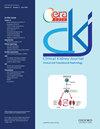囊性纤维化患者接受三联 CFTR 调节剂疗法对肾脏的影响
IF 3.9
2区 医学
Q1 UROLOGY & NEPHROLOGY
引用次数: 0
摘要
背景 Elexacaftor/tezacaftor/ivacaftor(ETI)是一种新型囊性纤维化跨膜传导调节剂(CFTR)调节剂,它改变了囊性纤维化患者(pwCF)的呼吸系统预后。然而,它对其他器官(如表达 CFTR 的肾脏)的影响仍不清楚。由于囊性纤维化患者有患肾病和尿路结石的风险,我们旨在研究 ETI 对肾功能、血容量状态和尿路结石风险因素的潜在影响。方法 这项前瞻性、观察性、单中心、前后队列研究涉及符合 ETI 条件的成年男性和女性儿童。通过比较采用 ETI 时(M0)和 7 个月后(M7)的肾功能(使用 2021 CKD-EPI 肌酸酐公式和 2021 CKD-EPI 肌酸酐-胱抑素 C 公式)、血容量状态(使用醛固酮/肾素比率和血压)和尿路结石风险因素,评估血浆和尿液特征的变化。结果 共纳入 19 例慢性肾功能衰竭患者。在 M0 和 M7 之间未观察到肾功能的明显变化(2021 CKD-EPI 肌酐:M0 时为 105.5 毫升/分钟/1.73 平方米,M7 时为 103.3 毫升/分钟/1.73 平方米;P = 0.17)。醛固酮水平(M0 时为 370.3 pmol/L 对 M7 时为 232.4 pmol/L;p = 0.02)和醛固酮/肾素比值(M0 时为 33.6 对 M7 时为 21.8;p = 0.03)均明显下降。在尿路结石的风险因素中,发现镁尿水平显著降低(M0 时为 4.6 mmol/d 对 M7 时为 3.8 mmol/d;p = 0.01)。结论 这些研究结果表明,ETI 似乎对成年 pwCF 的肾功能没有短期影响,而且似乎可以纠正因汗液流失过多而导致的继发性高醛固酮血症。还需要进一步调查,以确定在 ETI 治疗中观察到的镁尿减少对尿路结石风险的潜在影响。本文章由计算机程序翻译,如有差异,请以英文原文为准。
Kidney effects of triple CFTR modulator therapy in people with cystic fibrosis
Background Elexacaftor/tezacaftor/ivacaftor (ETI) is a new cystic fibrosis transmembrane conductance regulator (CFTR) modulator that has transformed the respiratory prognosis of people with cystic fibrosis (pwCF). However, its impact on other organs such as the kidneys, where CFTR is expressed, remains unclear. Since pwCF are risk of both kidney disease and urolithiasis, we aimed to study the potential effects of ETI on renal function, volume status, and risk factors for urolithiasis. Methods This prospective, observational, single-center, before-after cohort study, involved adult pwCF eligible for ETI. The changes in plasma and urinary profiles were assessed by comparing renal function (using 2021 CKD-EPIcreatinine and 2021 CKD-EPIcreatinine-cystatin C formulas), volume status (using aldosterone/renin ratio and blood pressure), and risk factors for urolithiasis, at the time of ETI introduction (M0) and 7 months after (M7). Results Nineteen pwCF were included. No significant change in renal function was observed between M0 and M7 (2021 CKD-EPIcreatinine: 105.5 mL/min/1.73m² at M0 vs. 103.3 mL/min/1.73m² at M7; p = 0.17). There was a significant reduction in aldosterone level (370.3 pmol/L at M0 vs. 232.4 pmol/L at M7; p = 0.02) and aldosterone/renin ratio (33.6 at M0 vs. 21.8 at M7; p = 0.03). Among the risk factors for urolithiasis, a significant reduction in magnesuria level was found (4.6 mmol/d at M0 vs. 3.8 mmol/d at M7; p = 0.01). Conclusion These findings suggest that ETI seem to have no short-term impact on the renal function of adult pwCF and appears to correct secondary hyperaldosteronism due to excessive sweat losses. Further investigations are needed to determine the potential impact of decreased magnesuria observed under ETI therapy on the risk of urolithiasis.
求助全文
通过发布文献求助,成功后即可免费获取论文全文。
去求助
来源期刊

Clinical Kidney Journal
Medicine-Transplantation
CiteScore
6.70
自引率
10.90%
发文量
242
审稿时长
8 weeks
期刊介绍:
About the Journal
Clinical Kidney Journal: Clinical and Translational Nephrology (ckj), an official journal of the ERA-EDTA (European Renal Association-European Dialysis and Transplant Association), is a fully open access, online only journal publishing bimonthly. The journal is an essential educational and training resource integrating clinical, translational and educational research into clinical practice. ckj aims to contribute to a translational research culture among nephrologists and kidney pathologists that helps close the gap between basic researchers and practicing clinicians and promote sorely needed innovation in the Nephrology field. All research articles in this journal have undergone peer review.
 求助内容:
求助内容: 应助结果提醒方式:
应助结果提醒方式:


